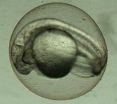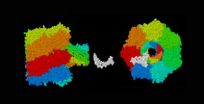(Press-News.org) Scientists from the University of Leicester have hit upon unique forms of spinal nerve activity that shape output of nerve cell networks controlling motor behaviours.
The breakthrough in the Department of Biology at the University of Leicester is announced today (5pm GMT on Thursday Nov 8) in the journal Current Biology. The three- year study was funded by the Biotechnology and Biological Sciences Research Council (BBSRC).
Although the neural basis of motor control has been studied for over a century, the processes controlling maturation of locomotor behaviours – like walking and swimming - are not fully understood.
The University of Leicester research into nerve cells responsible for motor behaviours was carried out on fish. The team aimed to understand how spinal networks produce rhythmic activity from a very immature stage - and how such activity changes during maturation.
The team used zebrafish, a freshwater fish native to northern India and Bangladesh, because their motor networks are similar to humans. However, as they are fertilized outside the mother and their embryos are transparent, scientists can readily monitor motor network development from its onset - something that is very difficult to do in mammals.
Lecturer in Neurobiology, Dr Jonathan McDearmid, who led the research, said: "What's unique about our work is the observation that a group of spinal nerve cells generate unusual forms of electrical activity that adapt to meet the changing requirements of the developing motor network. Whilst these cells had been previously identified, their excitable properties had not been studied in detail. We found that these cells produce age-specific activity patterns: in early life they have "autorhythmic" properties that are likely to drive embryonic movements. However, as fish develop towards more mature swimming stages, they switch firing activity to generate sustained impulses that appear to be necessary for maintenance of swimming.
"Our work is important because it sheds light on the mechanisms by which spinal nerve cells shape activity in the maturing of motor network. This is basic research that allows us to better understand how vertebrate motor activity emerges. However, in the long term, understanding of this process might help determine what goes wrong in diseases that affect spinal cord function."
Dr McDearmid said the identification of the activity generated by this group of cells –termed IC cells- happened as quite a surprise:
"It was two days after Christmas when we first observed IC cells generating these unusual patterns of activity. I was conducting a few routine experiments for a related study we were running in parallel. Whilst monitoring electrical responses in different nerve cells I hit on a cell that did some very unusual things. It was a very exciting finding indeed. The only problem was that subsequent attempts to find this "magic cell" didn't prove straightforward. Because these cells change location as the fish develops, it initially proved challenging to track them down for further study. Still, in time we figured out where these cells were and that very first recording turned out to be one of the best Christmas presents we've ever had."
Researchers say they have a long way yet to go in the study – and many questions remain unanswered. Dr McDearmid said:
"We have many questions that we want to ask next. Are there other cells in the developing spine that display similar types of activity? Also, we currently have no idea how IC cells function at more mature stages, such as in adult fish. Our next aim is to determine whether IC cells retain their unusual firing characteristics at older stages."
INFORMATION:
Dr McDearmid worked with Dr Huaxia Tong, a postdoc who co-authored the study.
NOTES TO NEWSDESK:
For more information please contact:
Dr Jonathan McDearmid, Department of Biology, University of Leicester
Tel: 0116 252 3913
Email: jrm33@le.ac.uk
About BBSRC
BBSRC invests in world-class bioscience research and training on behalf of the UK public. Our aim is to further scientific knowledge to promote economic growth, wealth and job creation and to improve quality of life in the UK and beyond.
Funded by Government, and with an annual budget of around £445M, we support research and training in universities and strategically funded institutes. BBSRC research and the people we fund are helping society to meet major challenges, including food security, green energy and healthier, longer lives. Our investments underpin important UK economic sectors, such as farming, food, industrial biotechnology and pharmaceuticals.
For more information about BBSRC, our science and our impact see: http://www.bbsrc.ac.uk
For more information about BBSRC strategically funded institutes see: http://www.bbsrc.ac.uk/institutes
Additional background information:
The University of Leicester research team was interested in how nerve cells networks dedicated to production of rhythmic motor behaviour (such as walking and swimming) form. These networks assemble within the spinal cord from a very early age, and they often start to generate behaviour before birth. However, they must undergo an intense period of maturation before being able of generate behaviours that we typically associate with adult life. Their work was aimed at understanding how spinal networks produce rhythmic activity from a very immature stage and how such activity changes during maturation.
The Leicester research team use the zebrafish because, like mammals, their motor maturation follows a stereotyped sequence of behavioural transitions that occur prior to the emergence of mature behaviour. This begins with rhythmic, periodic trunk contractions, akin to foetal movements that occur in mammals. Subsequently, as fish mature their motor networks switch output to generate swimming activity which, although quite simple, is a blueprint for adult behaviour.
The Leicester biologists aimed to shed light on the physiological mechanisms underpinning this process. They aimed to address two issues:
First - to understand how zebrafish spinal networks produce activity at very immature stages, when they contain very few nerve cells.
Second - to understand the maturation processes underpinning the progression from embryonic trunk contractions to more mature swimming behaviour.
Using a specialised technique ("patch clamp electrophysiology") the biologists monitored electrical properties of different nerve cell types in the developing zebrafish spinal cord.
The researchers found that most cells were unremarkable: when stimulated they produced brief, arrhythmic electrical discharges called "action potentials". However, one group of cells (the "IC cells") generated a very different form of activity. Stimulating these cells triggered prolonged, rhythmic "bursts" that closely resembled activity that drives embryonic trunk movements. Moreover, when IC cells were prevented from generating this activity, motor behaviour was abolished, suggesting the activity produced by these cells drive embryonic behaviour.
When biologists looked at more mature stages, when fish acquire the capacity to swim they saw that IC cells produced very different, yet equally unusual, forms of activity. On the transition to swimming, IC cells switched firing mode to produce powerful and sustained bursts that plateaued for tens of seconds. When the biologists blocked these discharges, fish could no longer swim for prolonged periods, a finding that suggests IC cells become important for maintenance of sustained swimming activity.
Unique spinal nerve cell activity discovery announced by University of Leicester biologists
Research team identifies novel forms of activity linked to development of motor behaviors such as swimming
2012-11-08
ELSE PRESS RELEASES FROM THIS DATE:
Rethinking body mass index for assessing cancer risk
2012-11-08
November 8, 2012 — (Bronx, NY) — A study by researchers at Albert Einstein College of Medicine of Yeshiva University suggests that body mass index (BMI)—the most commonly used weight-for-height formula for estimating fatness—may not be the best measure for estimating disease risk, and particularly the risk of certain types of cancer. The study was published today in the online edition of the American Journal of Epidemiology.
BMI is calculated by dividing a person's weight (in kilograms) by his or her height in meters squared, or W/H2. Most of the early studies that ...
Cells from skin create model of blinding eye disease
2012-11-08
MADISON — For the first time, Wisconsin researchers have taken skin from patients and, using induced pluripotent stem cell (iPSC) technology, turned them into a laboratory model for an inherited type of macular degeneration.
Dr. David Gamm, director of the UW's McPherson Eye Research Institute, said that while Best disease is relatively rare, having a patient-specific model of the eye disease, which destroys the macula of the retina, could lead to a greater understanding of more common eye disorders such as age-related macular degeneration.
"This model gives us a chance ...
Dream symbols could help in psychotherapy
2012-11-08
Dream images could provide insights into people's mental health problems and may help with their treatment, according to a psychology researcher from the University of Adelaide.
Dr Lance Storm, a Visiting Research Fellow with the University of Adelaide's School of Psychology, has been studying dream symbols (or "archetypes") and their meanings, as described by the famous psychologist and psychiatrist, Carl Jung.
In the early 1900s, Jung proposed that these archetypes were ancient images stemming from humans' collective unconscious. He believed that dream symbols carried ...
Injection is the best method for cutting ammonia emissions from slurry spreading on lands
2012-11-08
In order to contribute to the development of the primary sector and environmental care, the Basque Institute of Agricultural Research and Development, NEIKER-Tecnalia, has analysed various ways of spreading slurry on arable land to determine the most appropriate way of cutting the amount of ammonia that is released into the atmosphere.
The three methods studied were: the traditional splash plate or fan method, hanging pipes, or injection. The last one turned out to be the most environmentally friendly in terms of ammonia emissions (NH3), as it achieves a 93% cut in NH3 ...
Carbon dioxide – our salvation from a future ice age?
2012-11-08
Mankind's emissions of fossil carbon and the resulting increase in temperature could prove to be our salvation from the next ice age. According to new research from the University of Gothenburg, Sweden, the current increase in the extent of peatland is having the opposite effect.
"We are probably entering a new ice age right now. However, we're not noticing it due to the effects of carbon dioxide", says researcher Professor Lars Franzén.
Looking back over the past three million years, the earth has experienced at least 30 periods of ice age, known as ice age pulses. ...
Pull with caution
2012-11-08
As nanotechnology progresses, it becomes increasingly important to know in detail the dynamics of the nanoworld (the world at the scale of a millionth of a millimeter). What happens, for example, when we try to drive a polyelectrolyte (a long chain of electrically charged molecules, such as DNA) through a nanopore if knots cause the translocation process to jam? It's not a pointless question, because now a new DNA sequencing method to electrochemically analyze every single strand by driving it through a nanopore, is being developed. Since those strands tend to tangle up ...
Environmentally friendly chemistry important for manufacturing pharmaceuticals
2012-11-08
Limiting the quantity of catalysts – substances that trigger a chemical reaction – used in the manufacture of pharmaceuticals is important, and research from the University of Gothenburg, Sweden, has now demonstrated that small quantities of copper work well in this respect.
"This is an important finding, not just academically but also for industry," says chemist Per-Fredrik Larsson.
Catalysis is an incredibly valuable tool in the field of chemistry, with the Haber-Bosch process being one of the most important catalytic processes in the world. It is used to manufacture ...
What if the nanoworld slides
2012-11-08
A study published by Andrea Vanossi, Nicola Manini and Erio Tosatti - three SISSA researchers - in PNAS (Proceedings of the National Academy of Sciences) provides a new tool to better understand how sliding friction works in nanotribology, through colloidal crystals.
By theoretically studying these systems of charged microparticles, researchers are able to analyze friction forces through molecular dynamics simulations with accuracy never experienced before.
"There are several and very concrete potentialities", stated Andrea Vanossi, one of the members of the research ...
The brain of OCD sufferers is more active when faced with a moral dilemma
2012-11-08
Patients with obsessive-compulsive disorder are characterised by persistent thoughts and repetitive behaviours. A new study reveals that sufferers worry considerably more than the general population in the face of morality problems.
Along with the help of experts from the Barcelona's Hospital del Mar and the University of Melbourne (Australia), researchers at the Hospital de Bellvitge in Barcelona have proven that patients with obsessive-compulsive disorder, known as OCD, are more morally sensitive.
"Faced with a problem of this type, people suffering from this type ...
Cambridge software improves quality of sound for hearing aid users
2012-11-08
A new software product developed by researchers at the University of Cambridge could greatly improve sound perception for users of hearing aids.
The software prescribes the amount of amplification of high-frequency sounds required to restore the audibility of such sounds. This increases the frequency range of sound that individuals with hearing loss are able to detect, improving speech perception, sound localisation and the ability to hear certain musical sounds, when compared with current methods. Results of an evaluation of the software were published recently in the ...
LAST 30 PRESS RELEASES:
Heart-brain connection: international study reveals the role of the vagus nerve in keeping the heart young
Researchers identify Rb1 as a predictive biomarker for a new therapeutic strategy in some breast cancers
Survey reveals ethical gaps slowing AI adoption in pediatric surgery
Stimulant ADHD medications work differently than thought
AI overestimates how smart people are, according to HSE economists
HSE researchers create genome-wide map of quadruplexes
Scientists boost cell "powerhouses" to burn more calories
Automatic label checking: The missing step in making reliable medical AI
Low daily alcohol intake linked to 50% heightened mouth cancer risk in India
American Meteorological Society announces Rick Spinrad as 2026 President-Elect
Biomass-based carbon capture spotlighted in newly released global climate webinar recording
Illuminating invisible nano pollutants: advanced bioimaging tracks the full journey of emerging nanoscale contaminants in living systems
How does age affect recovery from spinal cord injury?
Novel AI tool offers prognosis for patients with head and neck cancer
Fathers’ microplastic exposure tied to their children’s metabolic problems
Research validates laboratory model for studying high-grade serous ovarian cancer
SIR 2026 delivers transformative breakthroughs in minimally invasive medicine to improve patient care
Stem Cell Reports most downloaded papers of 2025 highlight the breadth and impact of stem cell research
Oxford-led study estimates NHS spends around 3% of its primary and secondary care budget on the health impacts of heat and cold in England
A researcher’s long quest leads to a smart composite breakthrough
Urban wild bees act as “microbial sensors” of city health.
New study finds where you live affects recovery after a hip fracture
Forecasting the impact of fully automated vehicle adoption on US road traffic injuries
Alcohol-related hospitalizations from 2016 to 2022
Semaglutide and hospitalizations in patients with obesity and established cardiovascular disease
Researchers ‘listen in’ to embryo-mother interactions during implantation using a culture system replicating the womb lining
How changing your diet could help save the world
How to make AI truly scalable and reliable for real-time traffic assignment?
Beyond fragmented markets: A new framework for efficient and stable ride-pooling
Can shape priors make road perception more reliable for autonomous driving?
[Press-News.org] Unique spinal nerve cell activity discovery announced by University of Leicester biologistsResearch team identifies novel forms of activity linked to development of motor behaviors such as swimming




